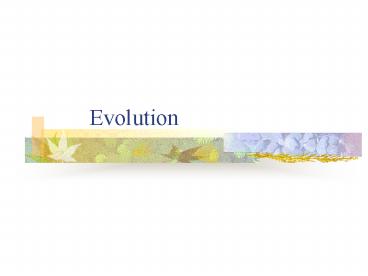Evolution - PowerPoint PPT Presentation
1 / 28
Title:
Evolution
Description:
Fossils 3. Comparative anatomy 4. Comparative embryology 5 ... Mammal Whale flipper Human arm Bat wing Cat limb Convergence converge =come together ... – PowerPoint PPT presentation
Number of Views:94
Avg rating:3.0/5.0
Title: Evolution
1
Evolution
2
Charles Darwin
- Natural Selection
- Survival of fit
- Fit reproduce
- Competition for resources
- Best adapted species survive
3
Evolution Evidence
- 1. Adaptations
- 2. Fossils
- 3. Comparative anatomy
- 4. Comparative embryology
- 5. Comparative Biochemistry
- 6. Plate Techtonics
4
1. Adaptations feautres suited to a particular
environemnt that allow organisms to survive
- Inuit people, who live in the extreme cold of the
Arctic, have short, stout bodies that conserve
heat.
5
- Masai people, who live in the arid lands of
eastern Africa, have tall, lean bodies that
disperse heat well.
6
2. Fossil Evidence
- Once living remains of organisms
- Limited
- Type of material preserved (bone, shell,
impressions, amber) - Incomplete record
- Easily disrupted
7
Plant Fossil Evidence
8
3. Comparative Anatomy Structural similarities
link related species
9
Comparative Anatomy Structures
- Homologous
- Same ancestor
- homosame
- Same underlying structures
- Different Functions
- Different Environments
- Analogous
- Different ancestors
- analogylike
- Different underlying structures
- Same Function
- Similar Environments
10
Analogous Structures
- Different underlying structures (different
ancestors) - Same function, similar environments
Fly wing
11
Homologous Structures
- Same underlying structures, different
functions, different environments common
ancestor
12
4. Comparative embryology
- Similar embryo development in closely related
species
13
5.Comparative Biochemistry
- Similar DNA sequences
- Similar Gene segments of the DNA
- Code for similar traits
- In closely related species
14
Early Theories of Evolution
- Lamark
- Use Disuse
- Abandoned
- No knowledge of genetic traits or mutations in
sex cells
- Darwin
- Current theory
- Natural Selection
- Survival of fit
- Reproduction of the best adapted species
15
Lamarks Theory
- Use and Disuse
- Use of structure results in evolution
- Does not take into account DNA or sex cell
mutations
16
Mechanisms of Natural Selection
17
Variations
- Differences in traits
- Come about by mutations in genes
- Random
- Occur in sex cells
- Passed on to future generations
18
Bird Beak Adaptations
19
Genetic DriftChanges in the gene pool due to
- Random mating
- Over a long time period
- No immigration of males
- No emigration of females
- Sufficient resources that match the adaptations
20
Same Species Must
- Show similar characteristics
- Successfully
- interbreed
- Producing fertile offspring
Donkey Horse Mule (infertile)
21
Speciation
- Evolution
- New Species
- Over time
- By Isolation
- Natural Barriers
22
Geographic Isolation
- Separation of organisms by geographic features
- Mountains
- Lakes, oceans, rivers
- Desserts
- (May result in new species over time)
23
Reproductive IsolationWhen two different species
can not mate and have successful offspring
- Geographic barriers
- Anatomy or physiology
- Social behaviors
24
Reproductive IsolationTwo organisms cannot mate
- Separated by geographic boundaries
- Anatomical differences
- Physiological differences
- Social behaviors
25
Gradualism
- gradual
- Small changes
- Over a long time
26
Adaptive Radiation
- radiation branching from one source
- adaptive survival of fit
- Evolution of many branches of organisms from a
single source
27
Divergence
Human arm
- diverge branch off
- Homologous structures
- Same origin
- Same underlying structure
- Difference functions
Bat wing
Cat limb
Whale flipper
Original Species Mammal
28
Convergence
Bird wing
- convergecome together
- Analogous features
- From different origins
- Similar environments
- Similar functions
- Different structures
Organisms that fly
Butterfly wing
Bat wing































